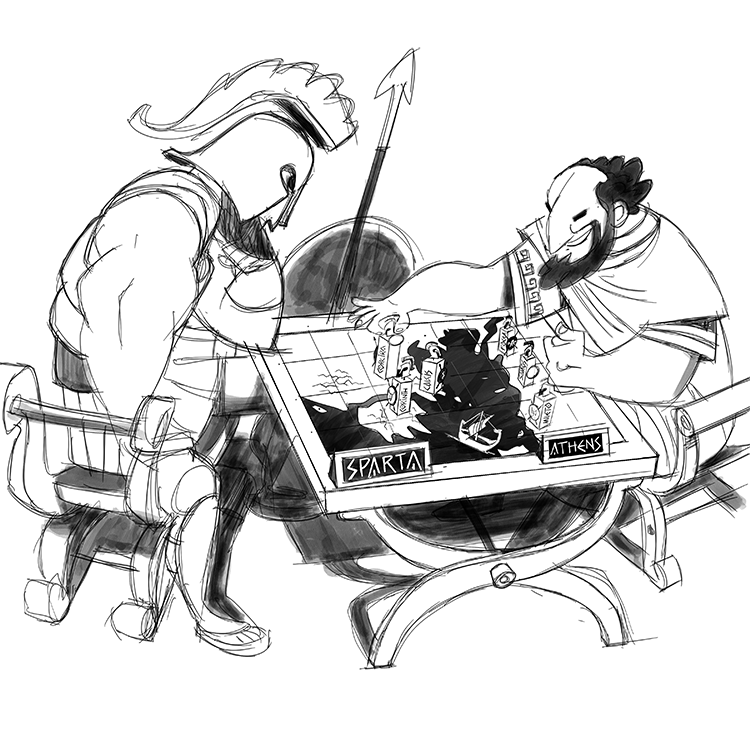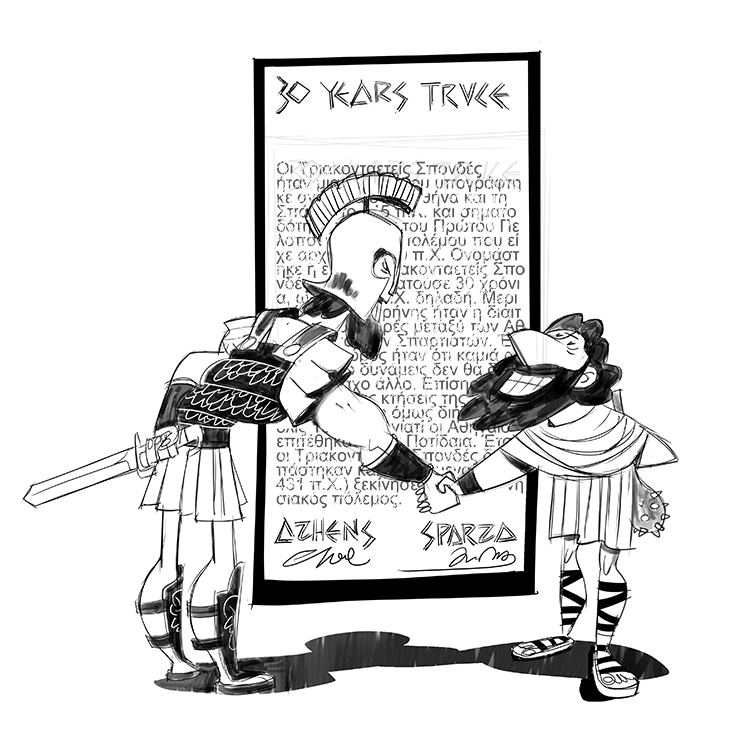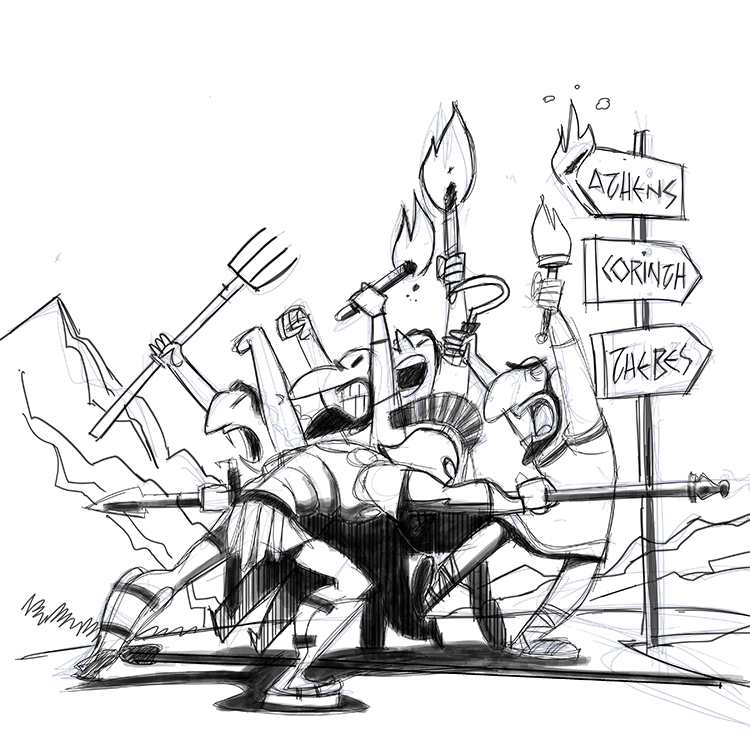It’s an unfortunate truth that human history has often been defined by war. Yet while war is tragic, it has also played a critical role in our history.
This fact is on full display in Ancient Greece. The ancient Greeks not only fought their neighbors (mainly the Persians), but they also fought amongst themselves. During this time there was no unified Greece. Instead, it was just a collection of independent city-states.
The two most powerful of these city-states — Athens and Sparta — fought frequently, though they only came face-to-face one time.
This conflict is known as the Peloponnesian War. It lasted almost 30 years and was devastating to both cities. But beyond defining the history of these two cities and the ancient world, the Peloponnesian War also had a profound impact on our modern, Western world.

The First Peloponnesian War
The rivalry between Athens and Sparta dates back to the beginning of the Classical Era (c.600 – c. 300). And tensions between the two had been bubbling since the end of the Second Persian Invasion during the Greco-Persian Wars (c. 480 BC), mainly because of Athens’ growing imperial ambitions.
But up until this point in history, the two most powerful city-states had never actually engaged in conflict with one another.
This would change mainly due to Athens’ efforts to antagonize the Spartans. It did this first by conquering part of Boeotia (the region of Thebes). Then it took Chalcis, which lies on the Corinthian coast not too far from Sparta.
To make things even more tense, Athens started opening its borders to Spartan helots, i.e. slaves. This oppressed segment of the population was the backbone of Spartan society. By allowing them to flee to Athens and gain their freedom, the Athenians were basically saying to the Spartans, “We’re coming for you!”
At this point, Sparta could no longer stand idly by, unless it wanted to accept Athenian rule. So, it began supporting Athens’ enemies in battles, marking the first time the two cities fought one another.
However, this series of conflicts, which many historians call the First Peloponnesian War, involved no formal declarations of war. Instead, the two sides fought a proxy conflict, using allied states at war with another to fight.
Eventually, it became clear that this fighting was not going to produce a clear winner. So, the two sides came together and agreed to Thirty Years’ Peace in 446 BC.
As the name suggests, this agreement committed the two sides to three decades without war. But since nothing was done to resolve the tension between the two, this peace was unstable at best.
People started taking bets to see if it would last the full thirty years. Okay, maybe not. But it’s likely few people, on either side, believed this truce would last for as long as intended.

The Second Peloponnesian War
Those who decided to bet the under on the Thirty Years Peace would have won big time. In fact, the truce lasted all of just 13 years, not even half of its original decree.
The first sign of the breakdown came in 440 BC when Athens made moves on the island of Samos, conquering it and adding it to its growing empire. This proved that Athens had no intention of stopping its expansion, which would have put Sparta on alert.
Then, in 443 BC, war broke out between Corinth and another Greek city-state, Corcyra, over who controlled a colony in northwestern Greece. Athens supported Corcyra, whereas Sparta, partly due to its involvement in the Peloponnesian League, helped Corinth. Once again, the two sides were fighting.
Finally, all illusions of peace between the two cities were shattered when a coup failed inside the city of Platea, the site of a famous battle from the Greco-Persian War.
Thebes, another powerful city-state in ancient Greece, decided to support a group of rebels within Plataea. But their plan failed and war broke out. Athens came to the aid of Plataea, and Sparta sent troops to support Thebes.
Once again, Athens and Sparta were fighting, and the (Second) Peloponnesian War was on.
Because it was far and away the more significant conflict, most historians refer to this part of the fight between Athens and Sparta as just the Peloponnesian War, though it was really the second round of a much larger conflict between the two cities.
The ways in which this war broke out give us a lot of insight into the nature of Greek politics at the time. Since all cities existed independently, power was always a game of alliances. Sparta was determined to stop Athenian expansion, but it wasn’t until Athens started attacking its allies that it decided to declare war on Athens.
Three Wars in One
After the events that took place at Plataea, it became clear to the Spartans that the Athenians wouldn’t stop until they were crushed completely. So that’s what they set out to do. Yet while the Spartans were much stronger militarily, it would take them nearly three decades to finally squash Athens.
But fighting during this time was not continuous. In fact, there were several attempts at peace, and these broke the Peloponnesian War up into three parts.
In the end, though, it took nearly thirty years for the two sides to agree that their dispute was over.
Part One: The Archidamian War (431-421 BC)
The first part of the Peloponnesian War is often known as the Archidamian War. This name comes from the Spartan king at the time, Archidamus II. Another name is the Ten Years’ War, which comes from, well, the fact that it lasted ten years.
This was the period of the war in which Athens had the best chance of winning. But the odds were not in their favor.
For starters, Athens began the war on the defensive. This allowed the Spartans to burn and pillage much of the farmland around the city. Then, a plague hit. Thanks to this disease, somewhere around one-third of the Athenian population died. But despite all of this, Athens went on the offensive and achieved several key victories on the Peloponnese.
Their crowning moment was at the Battle of Sphacteria. There, Athenian ships successfully trapped the Spartan army, capturing a large number of elite Spartan soldiers and forcing the Spartans to sue for peace.
Athens also managed to take several key ports along the coast of the Peloponnese. They then opened these places up to fleeing helots, a move designed to undermine Spartan society.
Thinking they really had the advantage, the Athenians refused Spartan’s peace offerings and continued fighting. But this wound up coming back to bite them. Shortly after their defeat at Sphacteria, the Spartans launched a campaign in northern Greece that brought the conflict into a stalemate.
At this point, a man named Nicias became the leader of the Athenian assembly and he brokered the Peace of Nicias. By now, most Athenians were tired of war and so he came into power with a mandate to bring it to an end. Plus, in the ten years of fighting, neither side was any closer to victory, so why bother?
The Peace of Nicias was meant to restore things to the way they were before fighting broke out. And it was meant to last fifty years. But we all know how things turned out when Athens and Sparta agreed to thirty years of peace…
Let the betting begin!
Part Two: The Interlude (421-413 BC)
The next period of the Peloponnesian War is often called The Interlude since it comes in between two eras of direct conflict between Athens and Sparta.
Once again, Athens made it very clear that the terms of the peace treaty it made with Sparta didn’t mean all that much. After signing it, it almost immediately started conquering new cities, the most significant being Melos in the southern Aegean.
From there, the Athenians decided to try their luck out west. They sent a large fleet to Sicily, hoping to conquer the main city on the island: Syracuse.
However, when they got there, they found out that the Greeks living there didn’t really want to be conquered. Surprise! So, they lingered for a bit, hoping to find allies amongst the non-Greeks living on the island. But all this did was give Syracuse time to prepare its defense.
Then, the Spartans and the Corinthians arrived to help Syracuse, and the Athenians were demolished.
The failed invasion of Syracuse not only dealt a crushing blow to the Athenian military, but it also proved, once again, that Athenian imperial ambitions had not been silenced. So, to try and stop them once and for all, Sparta declared war once again. The Peloponnesian War was back on, just eight years after the Peace of Nicias.
So much for fifty years without conflict…
Part Three: The Ionian War (413-404BC)
The last part of the Peloponnesian War is called the Ionian War because most of the fighting took place near the Ionian coast (the southwestern coast of modern-day Turkey).
However, before launching a campaign near Ionia, the Spartans decided to really stick it to the city of Athens. They moved their army into Attica (the region where Athens is located) and began burning farmland. But unlike in the first part of the war when the Spartans stopped raiding shortly after entering the region, this time they set up a base and kept their foot on the gas.
This cut off Athens from one of its primary sources of food.
At this point, the Spartans looked like they were ready to win. Seeing this, many cities previously allied with Athens started to break away, leaving the city increasingly isolated.
Then, to really drive the nail into the coffin, Sparta launched a naval campaign in the Aegean to try and chip away at Athens’ stronghold in that region.
At first, the Athenians won some victories that made it look like the war would go on forever. But then the Spartan king Lysander made a brilliant move. He sailed his fleet into the Hellespont, the tiny stretch of water in the northeast Aegean that separates Asia from Europe.
The Athenian fleet followed him, but then Lysander turned around and crushed his enemy. This not only wiped out the Athenian military, but it also cut off Athens from its only remaining source of food. With the little farmland near Athens burned and pillaged, the city was dependent on its allies and colonies in the Aegean for food. But when Lysander crushed the Athenian fleet and occupied the Hellespont, Athens could no longer import grain.
So, with no more military, and a starving population, the Athenians had no choice but to surrender. The Peloponnesian War, after nearly three decades, was finally over.

The Fall of Athens
After Athens surrendered, Thebes and Corinth, who had been fighting with the Spartans, wanted to burn the city to the ground. They were tired of Athens saying “We want peace,” only to start fighting again a year later.
However, Sparta rejected this notion, claiming that Athens was too important to overall Greek culture to be destroyed. This was a rather shocking move for the time. But despite this show of mercy, the Spartans still weren’t very nice to their vanquished rivals. They demolished Athens’ democracy and installed a group of pro-Spartan governors known as the Thirty Tyrants.
This group severely oppressed the Athenian population and made it so that Athens would not start up the conflict again. They were soon overthrown, but by then Athens had been reduced to a shell of its former self.

The Decline of Classical Greece
In many ways, the Peloponnesian War marked the beginning of the end of the Classical Era of Ancient Greece. After the fighting ended, Sparta became the hegemon (leader) of the Greek world. But this lasted for less than a century when Thebes emerged as a more powerful military force.
Thebes then dominated for a short period, but then they were crushed by the armies of Philip II of Macedon, who was then succeeded by Alexander the Great. The dominance of the Macedonians would last for nearly three centuries, and would end only with the invasion of the Romans.
So, in the end, Athens shot itself in the foot. By seeking more land and desiring more power, it invited in the fury of its neighbors. This plunged the Classical Greek world into war and eventually brought an end to an era.
Written by Matthew Jones
Illustrated by Pablo Velarde Diaz-Pache
